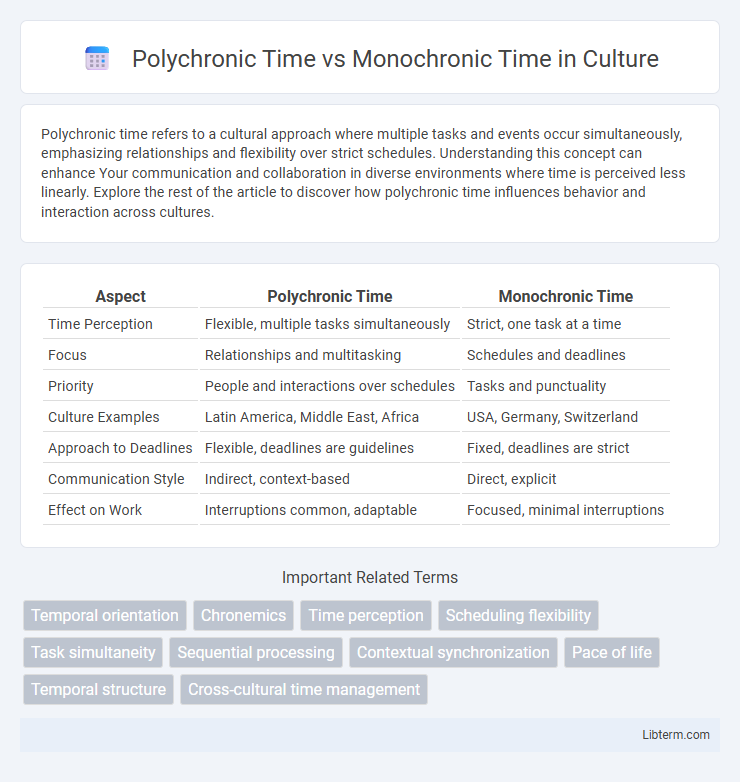Polychronic time refers to a cultural approach where multiple tasks and events occur simultaneously, emphasizing relationships and flexibility over strict schedules. Understanding this concept can enhance Your communication and collaboration in diverse environments where time is perceived less linearly. Explore the rest of the article to discover how polychronic time influences behavior and interaction across cultures.
Table of Comparison
| Aspect | Polychronic Time | Monochronic Time |
|---|---|---|
| Time Perception | Flexible, multiple tasks simultaneously | Strict, one task at a time |
| Focus | Relationships and multitasking | Schedules and deadlines |
| Priority | People and interactions over schedules | Tasks and punctuality |
| Culture Examples | Latin America, Middle East, Africa | USA, Germany, Switzerland |
| Approach to Deadlines | Flexible, deadlines are guidelines | Fixed, deadlines are strict |
| Communication Style | Indirect, context-based | Direct, explicit |
| Effect on Work | Interruptions common, adaptable | Focused, minimal interruptions |
Introduction to Polychronic and Monochronic Time
Polychronic time refers to a cultural perception of time where multiple tasks occur simultaneously, emphasizing relationships and flexibility over strict schedules. Monochronic time, in contrast, involves focusing on one task at a time with precise scheduling and punctuality. Understanding these time orientations is crucial for effective cross-cultural communication and management.
Defining Polychronic Time Orientation
Polychronic time orientation emphasizes multitasking and prioritizing relationships over strict schedules, where people engage in multiple activities simultaneously and adapt flexibly to changing circumstances. This cultural time perspective contrasts with monochronic time, which values linear, segmented tasks and punctuality. Polychronic individuals often view time as fluid, integrating social interactions into work and valuing emotional connections above rigid time management.
Understanding Monochronic Time Orientation
Monochronic time orientation prioritizes scheduling, linear task completion, and punctuality, emphasizing doing one activity at a time with strict adherence to deadlines. Cultures with a monochronic approach, such as the United States, Germany, and Switzerland, value efficiency, planning, and time management to ensure productivity. Understanding monochronic time helps businesses and individuals coordinate activities, meet expectations, and improve cross-cultural communication in professional settings.
Key Differences Between Polychronic and Monochronic Cultures
Polychronic cultures emphasize multitasking, flexible schedules, and prioritizing relationships over strict adherence to time, often viewing time as cyclical and fluid. Monochronic cultures value punctuality, linear time management, and completing tasks sequentially, treating time as a finite resource to be scheduled precisely. These fundamental differences impact communication styles, business practices, and social interactions across global cultures.
Historical Roots of Time Perception
The historical roots of polychronic and monochronic time perception stem from cultural evolution in ancient civilizations, where agricultural societies developed flexible, polychronic time systems to accommodate seasonal cycles and communal tasks. In contrast, industrialized societies reinforced monochronic time orientation, emphasizing structured schedules, punctuality, and sequential task management to maximize productivity. Anthropological studies highlight that these temporal frameworks reflect deep-seated social values and economic necessities shaped over centuries.
Cross-Cultural Examples of Time Management
Polychronic time cultures, such as those in Latin America and the Middle East, often prioritize relationships and multitasking, viewing time as fluid and flexible. In contrast, monochronic time cultures like Germany and the United States emphasize punctuality, schedules, and completing one task at a time, reflecting a linear approach to time management. Understanding these differences is crucial for effective cross-cultural communication and collaboration in global business environments.
Impact on Workplace Productivity and Collaboration
Polychronic time orientation encourages multitasking and flexible schedules, fostering collaboration through simultaneous involvement in multiple projects, which can enhance creativity but may reduce individual productivity due to divided attention. Monochronic time emphasizes linear task completion and strict scheduling, promoting efficiency and predictability in workflow but potentially limiting spontaneous teamwork and adaptability. Balancing these time orientations in diverse workplaces can optimize productivity by aligning task management with cultural preferences and collaboration needs.
Communication Styles in Polychronic vs Monochronic Societies
Polychronic societies prioritize relationship-building and fluid communication, often engaging in multiple conversations simultaneously and valuing context and nonverbal cues. Monochronic societies emphasize punctuality, linear communication, and completing one task at a time, favoring direct, explicit messages with clear agendas. These contrasting styles impact negotiation, conflict resolution, and daily interactions, influencing cross-cultural communication effectiveness.
Navigating Time Orientation in Global Business
Understanding polychronic and monochronic time orientations is essential for effective global business interactions, as polychronic cultures prioritize multitasking and flexible schedules while monochronic cultures emphasize punctuality and linear task completion. Adapting communication and project management styles to accommodate these differing time perceptions enhances collaboration and reduces misunderstandings in multinational teams. Companies that respect and integrate diverse temporal frameworks achieve higher efficiency and stronger cross-cultural relationships.
Adapting to Different Time Perspectives for Success
Adapting to polychronic and monochronic time perspectives enhances cross-cultural communication and organizational efficiency, as polychronic cultures prioritize multitasking and relational interaction, whereas monochronic cultures emphasize punctuality and sequential task completion. Successful leaders recognize these differences by tailoring project deadlines and meeting structures to align with diverse temporal expectations, thereby fostering collaboration and reducing conflict. Embracing flexible time management strategies supports global teamwork and drives productivity in multicultural environments.
Polychronic Time Infographic

 libterm.com
libterm.com